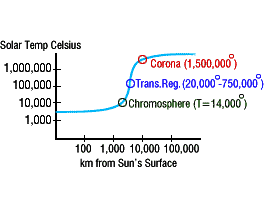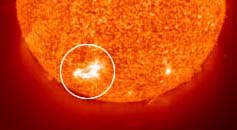
 |
|
| previous | educational resources |
|
TRACE works together with the Solar and
Heliospheric Observatory (SoHO), another satellite that is studying the Sun.
TRACE and SoHO will coordinate their observations and provide scientists with detailed information
about current conditions on the Sun. The TRACE mission is investigating several important solar
phenomena including: | |
|
Plasma Confinement
Maybe you've heard the Sun referred to a burning ball of gas. To be more precise, the material that makes up the Sun is actually called plasma. Plasma is a state of matter that forms when tremendous amounts of energy cause the bonds that hold atoms together to break apart. Plasma acts in some ways just like a gas. But on the Sun, plasma also does some pretty strange things.
| |
|
Plasma Heating
Loops are not the only weird thing that happen on the Sun. One of the weirdest, and most confusing of all solar phenomena is the plasma heating that takes place in the Transition Region, just above the Sun's surface. Think of a candle, or a space heater. Our experience is that the farther you get away from a source of heat, the cooler it will get. Makes sense, right? Not on the Sun.  This graph shows what happens to the temperature
as we move from the solar surface out into the solar atmosphere (Corona). For some reason, the
temperature increases dramatically throughout the Transition Region. The Sun's surface is a mere
5,000 degrees Kelvin. But 100,000 kilometers out into the Corona, the temperature jumps to nearly 2
million degrees Kelvin. Why? Again, scientists believe that the action of the Sun's magnetic field has
something to do with it. TRACE will collect data to help explain this strange increase in temperature.
This graph shows what happens to the temperature
as we move from the solar surface out into the solar atmosphere (Corona). For some reason, the
temperature increases dramatically throughout the Transition Region. The Sun's surface is a mere
5,000 degrees Kelvin. But 100,000 kilometers out into the Corona, the temperature jumps to nearly 2
million degrees Kelvin. Why? Again, scientists believe that the action of the Sun's magnetic field has
something to do with it. TRACE will collect data to help explain this strange increase in temperature.
| |
Solar Flares
 A solar flare is a sudden eruption of energy on the Sun's surface. Flares are important.
Even though they do not make any noticeable change in the brightness of the Sun, they can have
an effect on our lives here on Earth. While they only last a couple of minutes, large flares on
the Sun throw out sudden bursts of high energy radiation which can disrupt and even damage
communications system on Earth.
A solar flare is a sudden eruption of energy on the Sun's surface. Flares are important.
Even though they do not make any noticeable change in the brightness of the Sun, they can have
an effect on our lives here on Earth. While they only last a couple of minutes, large flares on
the Sun throw out sudden bursts of high energy radiation which can disrupt and even damage
communications system on Earth. Once again, solar physicists believe that disruptions in the Sun's powerful magnetic field plays an important role in the creation of solar flares. Another objective of the TRACE mission is to search for clues to help explain the relationship between flares and the Sun's magnetic field. |
| |Home|Mission|Instrument |Team|Operations|Results| Images| |
|
|
|
|
|
|
|
 |
|
|
|
Solar and Astrophysics Labs) |
|
|
email: hurlburt@sag.space.lockheed.com
| |